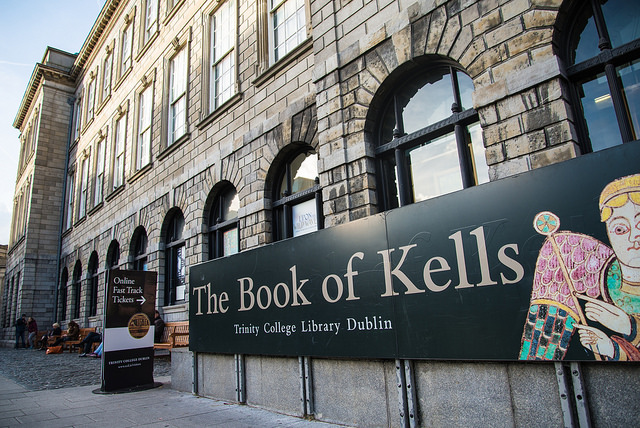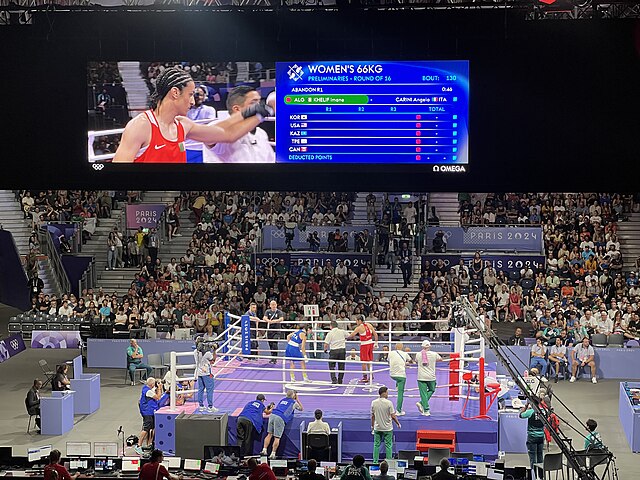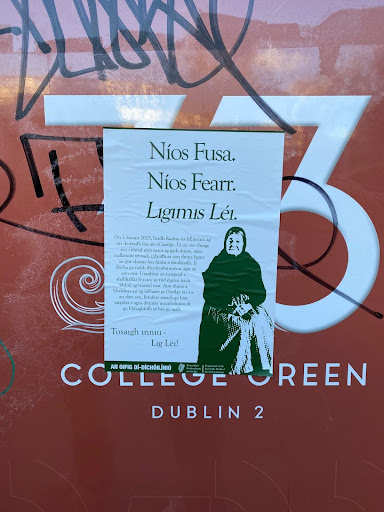The Book of Kells exhibition, which has remained unchanged for nearly 20 years, is to undergo a redevelopment that will see the construction of a new visitor centre in the Berkeley Podium, pending approval by the College Board in January.
The Library Treasures Exhibition Project will include a new, bigger Book of Kells exhibition, improved visitor facilities and larger Library shop, aimed at enhancing the experience for visitors and tourists. The redevelopment comes as Trinity is developing its commercial revenue streams and developing its reputation as a visitor attraction, as it diversifies its income streams away from state sources.
This redevelopment is part of the Trinity Visitor Experience, an ongoing project that will attempt to improve the overall visitor experience in Trinity. The project will also include a space that will exhibit student-curated displays.
The project will centre around the Old Library and the Berkeley Podium, relocating the Library Shop to the podium to create more space for a larger exhibition in the Old Library.
In an email to The University Times, Prof Veronica Campbell, Trinity’s Bursar and Director of Strategic Innovation, said that the purpose of this project is to “develop physical and virtual contemporary exhibitions of Library Treasures as a 21st-century experience of world-heritage items, uniquely in the context of a university environment”.
At a meeting of the College Board on September 21st, the current exhibition was described as “dated” and as not doing enough to attract many repeat visitors.
Helen Shenton, librarian and college archivist, told the College Board that the main aim of the project is to improve the experience of visitors and to showcase the various treasures and artefacts belonging to the library.
Trinity’s library holds hundreds of rare and important historical objects, including the Brian Boru Harp, Theobald Wolfe Tone and Edmund Burke’s death masks and 2,000 year-old ancient Egyptian statues. Minimising risk to the collections, showcasing new academic research and increasing revenue are also key parts of the project, along with enhancing the experience for non-English speaking visitors.
The Book of Kells exhibition was opened in 1998 as a temporary exhibition called Turning Darkness into Light. Since then, the popularity of the exhibition has increased dramatically, with over 750,000 tourists and visitors viewing the exhibition each year. This is despite the fact that the exhibition, as designed, originally planned for 250,000 visitors annually.
A document presented to the College Board by Trinity’s Commercial Revenue Unit in December 2015 and obtained by The University Times reveals that the library shop generated €884,000 in the 2014 financial year, while the Book of Kells itself raised just over €5 million.
The funds raised from the redevelopment will be used for conservation work in the Old Library, including the replacement of the Book of Kells display case.
The design team will be made up of Opera Amsterdam/Studio Louter, who will also consult on the exhibition design, Heneghan-Peng Architects, along with WH Stephens, who will provide a project manager and quantity surveying services.
Opera Amsterdam/Studio Louter have worked mainly within the arts, cultural and museum sector. Their previous projects include the National Museum of Denmark, the Victoria & Albert Museum in London and the Gallery of Humankind in Belgium. They will be consulting on the concept and design of the new exhibition.
Heneghan Peng Architects, founded by Róisín Heneghan and Shih-Fu Peng, is based in Dublin and Berlin. The firm has worked on significant projects such as the London Olympic Park footbridges, the Giant’s Causeway Visitors’ Centre and the Grand Egyptian Museum in Cairo, Egypt.
WH Stephens has been selected to provide a project manager for the project and quantity surveying services. The firm, established in 1865, has worked with Trinity in the past on Phoenix House and has worked with University of Ulster and Queen’s University Belfast.
In an email statement to The University Times, Shenton said the the project is “very exciting”, adding that she was “delighted” to have appointed “such internationally acclaimed architects and designers”.
The Trinity Visitor Experience project will see Trinity re-imagine and promote itself as a tourist attraction. As part of this, a refurbishment of Regent House, due to be completed in December, will see the space being used as a visitor centre in the summer months and revert back to its usual academic and society use during the academic year. The refurbishments will improve the accessibility of Regent House with the installation of an elevator and accessible toilets.
The Nassau St entrance is also currently being redecorated as part of the Trinity Visitor Experience. The entrance and concourse, which is due to be finished by the end of November, will see the replacement of the attendant’s kiosk with a seating area and the installation of new visual technologies all to better welcome visitors to Trinity.
In April 2014, The University Times reported that discussions had begun between the Library and the College, with the potential relocation of the Book of Kells from the Old Library to a new exhibition space beneath the Berkeley Podium.







